

 |
 |
 |
Guest - Not logged in | |||||||||||||||||||
Reviews > Clothing > Pants and Shorts > REI Sahara Convertible Pants > Test Report by Gail StaisilREIWomen's Sahara Convertible Pants Test Series by: Gail Staisil, Marquette, Michigan 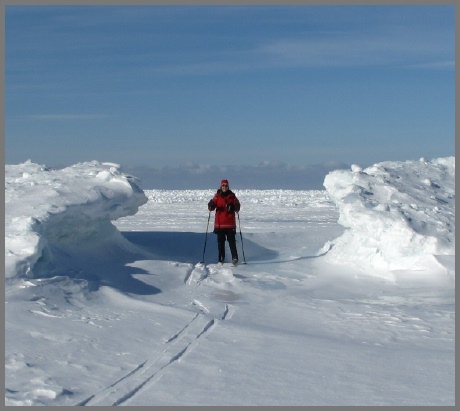
Page Contents: Initial Report: July 2, 2015 Tester Information Name: Gail Staisil Age: 62 Gender: Female Height: 5' 9" (1.75 m) Weight: 160 lb (73 kg) Location: Marquette, Michigan USA Email: woodswoman 2001 AT yahoo DOT com Product Information
Initial Impressions and Product Description 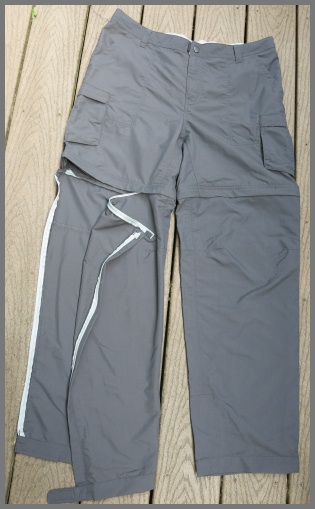 The REI Women's Sahara Convertible Pants arrived in the correct size and in the color of Asphalt (dark gray) and the Regular length of 32 in (81 cm). The pants zip off into shorts with an inseam of 7 in (18 cm). The workmanship was mostly great except for some hanging threads here and there. The Sahara Pants have been a mainstay of REI for a long time. They have changed the product through the years and I even found several differences from a pair I purchased two years ago. The pants have a relaxed fit and are additionally available in Petite, Plus, Girl's and Men's Sizes (with choices of inseam lengths). The pants also have a traditional rise meaning that the pants are not low-cut and sit right at the waistline. The pants are fabricated with lightweight nylon with a DWR finish. I would consider the pants utilitarian looking and well suited for hiking. What makes these pants unique in the world of convertible pants is that they feature No-Sit Zips. The lower legs of the pants have full-length zippers that can be zipped off without sitting down. This likely makes it very handy to remove the lower portions without 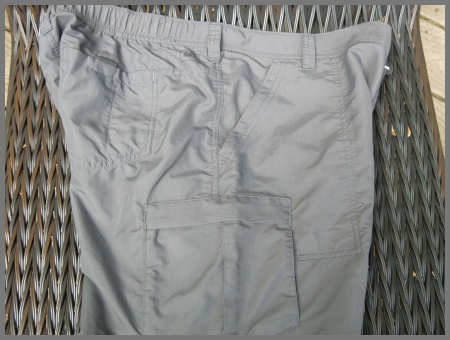 having to pull them off over
muddy boots. having to pull them off over
muddy boots. The No-Sit Zips have another feature that became apparent as I zipped them off. The hidden-with-a-flap zippers are color coordinated for each leg so that there is no question as to what leg (when separated) goes back to the appropriate side. One of the zipper sets matches the pants perfectly while the other set is a very light gray. I can't tell you how many times I have put the wrong bottom portion on the wrong leg with other pants I own. Some of it was not paying attention but other times I thought I was doing it right. This hopefully will solve that issue! Each zippered end of the lower legs portion of the pants is secured with an additional hook-and-loop tab covering. Each bottom edge features a lengthy tab of about 3 in (7.6 cm) allowing adjustment in the width of the pants. The upper edge has a small tab which likely helps to keep the flap closed more securely. The lower edge inner leg sections are also reinforced with an additional layer of fabric in an inverted U-shape placement. These reinforcements measure about 6.5 in (16.5 cm) in length and about 4.5 in (11.43 cm) in width. The lower portion of the pants also feature some articulation at the knees (darts) but overall the lower portion is wide all the way down. 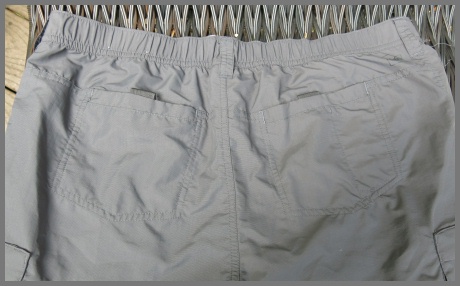 There is a plethora of pockets on the pants. The two rear pockets are located about 3 in (7.6 cm) below the waistline and are identical except for the right rear pocket that also includes an inner narrow but long pocket. Both rear pockets can be accessed with a tab (twill fabric) opening that is secured with a hook-and-loop closure. I am not really a fan of rear pockets but these are unobtrusive so they likely would not catch on anything. The interior lining of those pockets feature mesh fabric at the lower end for drainage. The pockets measure about 5 in (12.7 cm) square with the extra inner pocket measuring 1.75 in (9.5 cm) wide. The front angle pockets are roomy and are located one on each side (9.5 in/24 cm long and 6 in/15.2 cm wide). One of the pockets has an inner pocket with hook-and-loop closure to secure a very small item such as a key. It measures about 3.5 in (9 cm) long and 3 in (7.6 cm) wide. Overlying the bottom edge of each angle pocket are large cargo-style pockets which are centered over the side seams. These have expansion folds so that they can accommodate a three dimensional object. The bottom expansion features tightly woven mesh fabric to drain moisture. These 6 in (15.24 cm) in length by 6.5 in (16.5 cm) wide pockets feature zipper closures that are hidden by fabric flaps. 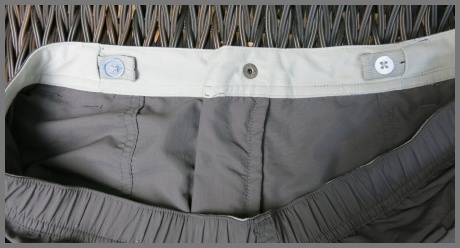 The waistband of the pants features an elasticized back as well as an adjustment component for the front portions of the band. The latter features a tunneled elasticized band on each side that can be pulled out and buttoned shut in a variety of button holes on the elastic band. I am looking forward to this detail as oftentimes the longer the hike, the looser pants become during the hike. Too bad this doesn't transfer long term when I come home :) The waistband also secures with a simple snap in the center of the front above the fly zipper. I think I'm excited about the new adjustment feature on the Saharas as my old Saharas had a belt instead of the elastic button feature. The waistband does feature five belt loops for those who are inclined to use a belt (not included anymore). The inside of the waistband is also lined with a very soft sueded material. Another comfort feature is a rectangular-shaped gusset measuring 2.5 in (6.35 cm) in width and 12.5 in (31.75 cm) in length. The majority of the seams on the pants are double stitched for wear and also lay flat for comfort while wearing. The Sahara Pants are easy to care for according to the tag sewn into the bottom of the waistband. They should be machine washed cold, no bleach and tumble dried. Can iron if necessary but they should not be dry cleaned. I am looking forward to trying the Sahara Convertible Pants especially with the new features on the latest model of these pants. Top of Page Field Report: September 6, 2015 USA Locations and Conditions During the testing period I have spent ten days backpacking and have enjoyed the outdoors most other days. Locations of all trips were in the State of Michigan and ranged from lakeshore to boreal forest. Elevation ranged from above 600 ft (183 m) to 2,000 ft (61 Location of Trip: Grand Island National Recreation Area, Lake Superior - State of Michigan Length of Trip: 2 days/1 nights (July 8-9) Pack Weight: Approx 22 lb (10 kg) Sky and Air Conditions: Sunny Precipitation: None Temperature Range: 42 F to 74 F (6 C to 23 C) Location of Trip: Isle Royale National Park Length of Trip: 6 days/5 nights (August 21-26) Pack Weight: 26 lb (11.8 kg) Sky and Air Conditions: Cloudy, rain, and very little sun Precipitation: 1.12 in (2.84 cm) Temperature Range: 43 F to 78 F (6 C to 26 C) Location of Trip: Grand Island National Recreation Area Length of Trip: 2 days, 1 night (September 3-4) Pack Weight: 23 lb (10.4 kg) Sky and Air Conditions: Warm, humid and sunny Precipitation: None Temperature Range: 58 F to 76 F/14 C to 24 C (Humidity ranged from 71-99 percent) ------------------------------------------------------ Trip Talk 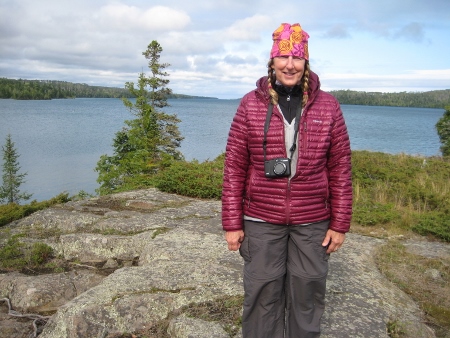 During the field test period I first traveled to Grand Island National Recreation Area. The weather was warm and the mosquitoes were the worst I have seen on the island in at least a decade. As soon as I stepped off the ferry the assault was rampant. I was glad I was wearing the Sahara Pants as they can't penetrate through the nylon fabric. Needless to say that even though it was hot (high of 74 F/23 C) and the humidity was probably 70-80 percent, there was no way I was going to remove the bottom of the pants legs to convert them to shorts! In the evening along the beach I did roll the pants up some while walking in the water for two miles (3 km). The mosquitoes are normally not a problem at the edge of the very cold water..go figure! The pants were mostly comfortable during the heat of the day and of course much more so when the evening temps rolled around. At Isle Royale National Park, the days were mostly rainy. The weather was cool while I was there often hovering between 45-60 F (7-16 C). As I do with other pants I own, I use them in "shorts form" underneath my rain pants. That way I stay cooler and the bottom of the pants never get wet from wicking. Upon arrival at camp and subsequent lapses in rain, I removed the rain pants and again put on the lower sections of the pants. The full lower-leg zippers make this easy to do without removing my shoes if desired. Recently I went back to Grand Island National Recreation Area to circumnavigate the outer trail on the island. It is over 21 mi (33.8 km) in length which I covered in two days. It was quite warm and humid with no wind to speak of. I became overheated quite quickly which is normal for me in such conditions. I first vented the pants opening the circular leg zippers part way but then decided to use them in the shorts version. I must add that the mosquitoes are still an issue over there (although not like they were earlier this summer) so I sprayed my legs with bug dope to make this work. All was fine and I was definitely more comfortable. Not only do I find the pants comfortable with no restricted areas but I like the fact that they are relatively light weight and not bulky. I love the adjustment feature on the waistband. I have also worn the pants for day hiking and casual wear. During dayhikes the pant legs stayed on due to buggy conditions and brush. I have been happy that the above-the-knee zippers don't irritate my skin while I hike. I have used the front pockets to store my hiker wallet (basically a silnylon zippered credit card-size envelope. I also store my keys in the pockets when I am day hiking. I do like the security zippers on the lower pockets so I don't often use the upper pockets. The pockets in the back have remai 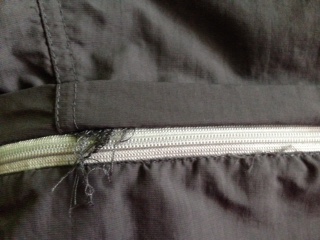 ned
unused (which is normal for me) but I am glad that they have
remained closed with the hook and loop tabs and glad that since the
pockets are stitched in place, they don't add a bunch of bulk. ned
unused (which is normal for me) but I am glad that they have
remained closed with the hook and loop tabs and glad that since the
pockets are stitched in place, they don't add a bunch of bulk.These recent trips were unusual summer trips for me as I didn't wash the pants in the field. The temps and conditions just didn't allow it on the longer trip and it wasn't necessary on the two short trips. I have washed the pants a multitude of times at home however. They are just washed with my other outdoor clothing and line dried. So far the pants show no sign of wear. I did discover however that under one of the leg zippers in the back that there was a large area of looped thread. I have been reluctant to pull them out as they haven't caught on the zipper as yet. I hesitate because I'm not sure if the seam would unravel as well. I will attempt to cut this in the LTR to see what happens but not until after my next long trip. Top of Page Long Term Report: November 10, 2015 USA Locations and Conditions During the testing period I have spent twenty-one days backpacking and ten days car camping and have enjoyed the outdoors most other days. Locations of all trips were in the States of Michigan, Washington and Minnesota and ranged from lakeshore to boreal forest. Elevation ranged from above 600 ft (183 m) to over 7800 ft (2377 m). Location of Trip: Pacific Crest Trail north of Rainy Pass, Mt Rainier National Park, Goat Rocks Wilderness, all in the State of Washington Length of Trip: 9 days, 8 nights (September 12-20) Pack Weight: Approx 28 lb (12.7 kg) Sky and Air Conditions: Cloudy, foggy, snow, rain and sun Precipitation: snow/rain Temperature Range: 26 F to 59 F (-3 to 15 C) Location of Trip: Porcupine Mountains Wilderness, Michigan Length of Trip: 3 days, 2 nights (September 25-27) Pack Weight: 25 lb (11.3 kg) Overloaded with good stuff Sky and Air Conditions: Warm, humid and sunny Precipitation: None Temperature Range: 57 F to 76 F (14 C to 24 C) Location of Trip: Porcupine Mountains Wilderness, Michigan Length of Trip: 4 days, 3 nights (October 2-5) Pack Weight: 23 lb (10.4 kg) Sky and Air Conditions: Cool, sunny and cloudy Precipitation: None Temperature Range: 28 F to 59 F (-2 C to 15 C) Location of Trip: Cook County/Grand Marais, Minnesota Car camping trip while doing work/study at folk school and day hiking Length of Trip: 10 days, 9 nights (October 16-25) Sky and Air Conditions: Cold, sunny, cloudy and rain Precipitation: 0.58 in (1.47 cm) of rain Temperature Range: 24 F to 55 F (-4 C to 13 C) Location of Trip: Porcupine Mountains Wilderness, Michigan Length of Trip: 3 days, 2 nights (October 30- November 1) Pack Weight: 23 lb (10.4 kg) Sky and Air Conditions: Clouds, rain and wind Precipitation: 0.76 in (1.93 cm) Temperature Range: 31 F to 45 F (-1 C to 7 C) Location of Trip: Pictured Rocks National Lakeshore, Michigan Length of Trip: 2 days, 1 night (November 9-10) Pack Weight: 23 lb (10.4 kg) Sky and Air Conditions: Clouds and sun Precipitation: None Temperature Range: 35 F (2 C) to 56 F (13 C) During the long term period I feel like I have been living in the field (not everyday camping but away from home in general). I have been away from home all but a week total in the last 8 weeks. The REI Sahara Pants have been an integral part of my travels. My first trip during the final two months was to the State of Washington. The trip included a six-day backpack trip and the other days were spent day hiking. The pants performed admirably with comfort being the key attribute. I love the soft waistband and the adjustable nature of it. Usually after a few days on the trail my waistband on most pants are a little too big. It is only a temporary situation though, but it helps to be able to adjust the band so that the backpack doesn't push the waistband below where it should be. Due to mostly cool weather on this trip I felt no need to remove the bottom portion of the pants. Heck we even had snow one afternoon and evening! The pants are comfortable while walking but they do feel a little chilly when hanging around camp. I solved that problem by removing them after setting up camp and putting on a pair of long woolies as well as lightly insulated down pants instead. My next two trips were to the Porcupine Mountains Wilderness in Michigan. The first trip had unseasonably warm temperatures for late September. The pants worked fine for hiking and rowing. The next trip was more par for the course temperature-wise so the pants worked well during the day and I switched to insulated pants at camp. My next trip was a base camp of ten days while I was doing work/study. I felt I had to look somewhat presentable each day so I sw 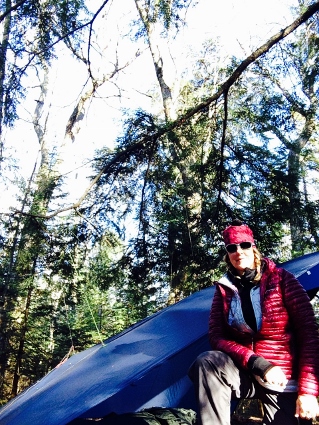 itched
out the pants a few times with other pants to make it at least look
like I had other clean clothes to wear. I have no doubt that I could
have worn the same REI pants the entire time but I preferred to not
do that. Work included stacking a couple cords of wood as well as a
lot of cleaning, setting up and dismantling classrooms/work shops,
setting up a 18 ft (5.5 m) yurt, etc. itched
out the pants a few times with other pants to make it at least look
like I had other clean clothes to wear. I have no doubt that I could
have worn the same REI pants the entire time but I preferred to not
do that. Work included stacking a couple cords of wood as well as a
lot of cleaning, setting up and dismantling classrooms/work shops,
setting up a 18 ft (5.5 m) yurt, etc.The next trip was an a backpacking trip back to the Porcupine Mountains. Steady rain was predicted and it did not disappoint. Only the first few hours of the trip were spent without rain gear. I layered the Saharas with the rain pants to keep me warm in very soggy damp conditions. My last trip was a short overnight trip to Pictured Rocks National Lakeshore hiking over 10 mi (16 km). The temps topped out at 56 F (13 C) which is unusually warm for November. The pants were fine to wear while hiking but at camp I switched to long underwear and lightly insulated pants as the temps dipped during the evening. The length of the pants has been perfect, neither dragging on the earth or being too short. Regarding the looped threads I mentioned in the field report, I decided to cut and pull them out with no ill effects. They were probably just a length of thread that was looped around and not checked by the manufacturer. During the long term period the weather was mostly cool as referenced above. For that reason I didn't make the pants into shorts for the entire period. I have washed the pants at least two dozen times during the test period. They just go in with my regular wash of outdoor clothing and I have always put them on a drying rack. They dry quick enough even in Michigan's somewhat humid environment (mostly between 60 and 80 percent). After examining the pants I don't really see any wear marks and they look good as new. The color of the pants has probably helped with keeping their appearance fresh. Overall I find the REI Sahara Pants to be very comfortable in a variety of temperature ranges while hiking. They are cool during non activity when the temps dip below 50 F (10 C). I tried layering them with long woolies but their fit on me doesn't allow it to be super comfortable. A little too binding for me in the thigh area. Pros
Tester Remarks Thanks to Recreational Equipment, Inc. and BackpackGearTest.org for this opportunity to test the Sahara Pants. This concludes my Long Term Report and the test series. Top of Page Read more reviews of REI gear Read more gear reviews by Gail Staisil Reviews > Clothing > Pants and Shorts > REI Sahara Convertible Pants > Test Report by Gail Staisil | ||||||||||||||||||||